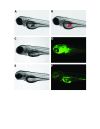Hooking the big one: the potential of zebrafish xenotransplantation to reform cancer drug screening in the genomic era
- PMID: 24973744
- PMCID: PMC4073264
- DOI: 10.1242/dmm.015784
Hooking the big one: the potential of zebrafish xenotransplantation to reform cancer drug screening in the genomic era
Abstract
The current preclinical pipeline for drug discovery can be cumbersome and costly, which limits the number of compounds that can effectively be transitioned to use as therapies. Chemical screens in zebrafish have uncovered new uses for existing drugs and identified promising new compounds from large libraries. Xenotransplantation of human cancer cells into zebrafish embryos builds on this work and enables direct evaluation of patient-derived tumor specimens in vivo in a rapid and cost-effective manner. The short time frame needed for xenotransplantation studies means that the zebrafish can serve as an early preclinical drug screening tool and can also help personalize cancer therapy by providing real-time data on the response of the human cells to treatment. In this Review, we summarize the use of zebrafish embryos in drug screening and highlight the potential for xenotransplantation approaches to be adopted as a preclinical tool to identify and prioritize therapies for further clinical evaluation. We also discuss some of the limitations of using zebrafish xenografts and the benefits of using them in concert with murine xenografts in drug optimization.
Keywords: Cancer; Drug screening; Microenvironment; Xenotransplantation; Zebrafish.
© 2014. Published by The Company of Biologists Ltd.
Figures


References
-
- Amatruda J. F., Shepard J. L., Stern H. M., Zon L. I. (2002). Zebrafish as a cancer model system. Cancer Cell 1, 229–231 - PubMed
-
- Bansal N., Davis S., Tereshchenko I., Budak-Alpdogan T., Zhong H., Stein M. N., Kim I. Y., Dipaola R. S., Bertino J. R., Sabaawy H. E. (2014). Enrichment of human prostate cancer cells with tumor initiating properties in mouse and zebrafish xenografts by differential adhesion. Prostate 74, 187–200 - PMC - PubMed
-
- Beckman M. (2007). Zebrafish take the stage in cancer research. J. Natl. Cancer Inst. 99, 500–501 - PubMed
-
- Beckwith L. G., Moore J. L., Tsao-Wu G. S., Harshbarger J. C., Cheng K. C. (2000). Ethylnitrosourea induces neoplasia in zebrafish (Danio rerio). Lab. Invest. 80, 379–385 - PubMed
Publication types
MeSH terms
Grants and funding
LinkOut - more resources
Full Text Sources
Other Literature Sources

